CES 2013 was exciting - what with the new OLED TVs and Flexible OLED prototypes and launches. Barry Young from the OLED Association, one of the world's top OLED experts, gave us his views on the new OLED developments from Samsung, Sony, LG and Panasonic. Thanks Barry!
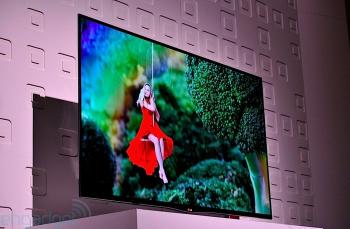
Sony and Panasonic both showed 4K2K 56" OLED TVs, with some parts jointly developed. How close are these two companies to actual mass production?
There wasn't a lot of information available on the two 56 4K AMOLED TVs, but we can extrapolate from what was provided.
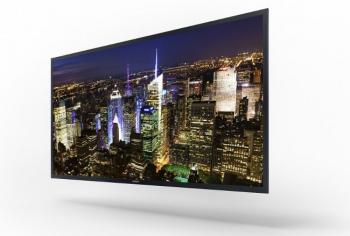 Sony's 4K 56-inch OLED prototype
Sony's 4K 56-inch OLED prototype
Sony’s 4K 56 TV was manufactured by AUO and Sony claimed that they used their own 'Super Top Emission' technology, which means RGB patterning with a FMM covered by a color filter that enhances the perfection of the colors and also functions as a substitute for a circular polarizer. The downside to this approach is cost, higher power consumption and lower lifetime. The current must be increased to adjust for the light losses in the color filter. Sony claims that their experience with the XEL-1 demonstrated that the lifetime (time to ½ luminance) was > 30,000 hours or 8 years at 10 hours per day. The TV on the CES floor was extraordinary, didn't seem to cut any corners and had excellent color and grey scale performance.
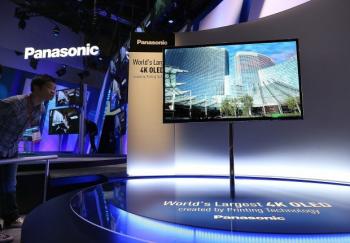
Panasonic claimed that the TV was printed, meaning that they likely used a combination of VTE for the transport layers and ink jet printing for the light emitting layers (RGB). The staff in the booth had no information about the TV and reportedly did not even know that the TV would be available until 1 day prior to the start of the show.
Aside from the size and resolution, the other common attribute was the use of IGZO for the active matrix. It leads to an assumption that the backplanes were produced by AUO and then shipped concurrently to both Sony and Panasonic where the organic layers and electronics were applied.
The latest date that Panasonic indicated AMOLED TVs would be available was 2014; although they previously indicated an earlier date. Sony has not gone public with any date. I believe the demonstration of the 56 4K TVs is a great sign that these companies are serious but the availability is still way in the future. They will no doubt have yield issues similar to those experienced by Samsung and LG Display. The practical issue for all OLED TV panel makers is that the availability of a competitive and large (84) 4K LCD TV, which are quite good, limits the price that can be charged for 55 OLEDs. Therefore, OLED panel makers are constrained by costs and cannot simply charge prices that are 5 to 10X the competition and access the early adopter market. Samsung seems to have backed off releasing TVs until they can get the yields up in order to reduce or eliminate losses until MP is attained.
When do you estimate that Samsung will be able to start producing flexible OLED (YOUM) displays? What kind of volume and display types can we expect?
Samsung had provided some guidance that YOUM displays would be available in late 2012, but they were unable to deliver. They are now indicating sometime in late 2013, but are making no commitments. They have ordered and are installing some equipment but will likely have a single Gen 5.5 line at 8K substrates per month until they are comfortable with the yield and performance. No applications have been mentioned but it is likely that they will use the thin, light and robust features before they start producing curved or flexible displays.
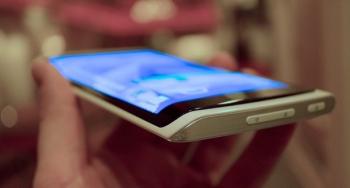
Both Samsung and LG Display are in OLEDs for the long term and have figured out that they cannot accurately forecast delivery of new technology, but they are firm in their beliefs that the technology will be differentiated and the costs will be competitive. Each company continues to appropriate CAPEX for OLEDs in a strategic fashion, while committing spending for LCDs tactically.
DisplaySearch says that both Samsung and LGD are currently focusing on 4K2K and "delaying" OLED TVs... what's your view here?
Both Samsung and LG have separate groups working on LCDs and OLEDs, so the priorities in one group (LCDs) don’t necessarily effect the priorities of another group (OLEDs). If you look at the Capex for Samsung and LG, they are putting relatively more investment in OLEDs than LCDs.

What CES showed is that LG is ready to ship 55 OLEDs commercially and Samsung is not. Samsung still faces issues, which prevent them from getting OLED TVs to market. The media has missed this point. SMD has always said that they would ship OLED TVs if LG did. Well LG is taking orders and SMD is not and they are not saying when they will be ready to ship or take orders. This is a big win for LG, especially since they are using IGZO. It will be the largest display using IGZO for LCDs or OLEDS.
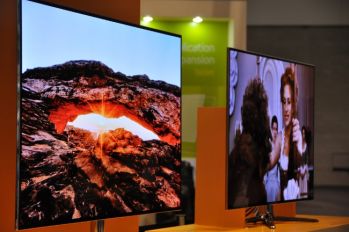
Regarding LCDs with 4K, they will ship into a very limited market. In 2013 the market for TVs 50 and greater is expected to be 15 to 20M units or around 5% to 7%. The experts believe that 4K by 2K will likely be differentiated only when the display is 84 at the subscribed viewing distances and the lack of 4K media, means that all the software has to be up converted reducing the benefit. So that would take the market size down to

The real question for AMOLED TV makers is can they compete in the 42 and under category which represents 90% of the TV market. If not why bother, they will never recover their investments if they stick to the 55 and over category.
Comments
an Indium-Tin-Zinc-Oxide tft, which is developed by Sony, and Panasonic had also claimed that the backplanes they used is provided by Sony
BTW, from the subpixel structure and the details from some close photos provided by japanese media, Sony's oled tv uses a hybrid structure of printing & evaporation, which means AUO only did the evaporation job in the production of this panel


the colour filter only aims to purify the colour
not like the LG WOLED+CF, Sony's STE OLED still uses a real RGB sub-pixel structure, and with the most efficient blue material, sure it has a longer lifetime than most oled displays we have seen already